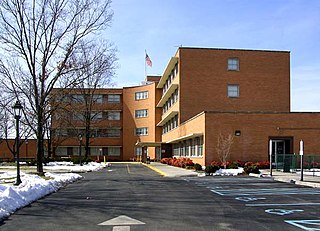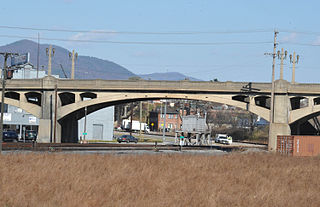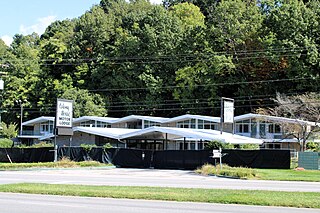
Roanoke is an independent city in the U.S. state of Virginia. It is located in Southwest Virginia along the Roanoke River, in the Blue Ridge range of the greater Appalachian Mountains, approximately 50 miles (80 km) north of the Virginia–North Carolina border and 250 miles (400 km) southwest of Washington, D.C., along Interstate 81. At the 2020 census, Roanoke's population was 100,011, making it the largest city in Virginia west of the state capital Richmond. It is the principal municipality of the Roanoke metropolitan area, which had a 2020 population of 315,251.

The North Loop is a neighborhood in the Central community of Minneapolis.

The James River and Kanawha Canal was a partially built canal in Virginia intended to facilitate shipments of passengers and freight by water between the western counties of Virginia and the coast. Ultimately its towpath became the roadbed for a rail line following the same course.

The Grandin Road Commercial Historic District, also referred to as Grandin Village, is a historic district listed on the National Register of Historic Places located in the Raleigh Court neighborhood of the independent city of Roanoke, Virginia. Centered at the intersection of Memorial Avenue and Grandin Road, Grandin Village hosts an array of independently owned retail and dining establishments. The district has been noted as one of Roanoke's best examples of a mixed-use urban village, and has been used as a local model for future mixed-use developments within the community.

Wasena is a Roanoke, Virginia neighborhood located in south, central Roanoke bisected by U.S. Route 221, immediately to the south of the Roanoke River. It borders the neighborhoods of Raleigh Court on the west, Old Southwest on the north and east and Mountain View via the Wasena Bridge across the Roanoke River on the north, and Franklin-Colonial on the south. As of the 2000 U.S. Census, Wasena has a population of 1,633 residents.

Raleigh Court is a Roanoke, Virginia neighborhood located in southwest Roanoke along U.S. 11. It borders the neighborhoods of Greater Deyerle on the west, Wasena on the east, Cherry Hill, Mountain View and Norwich on the north and Franklin-Colonial and Grandin Court on the south. Today the neighborhood is accessed from the downtown areas via the Memorial Bridge across the Roanoke River. As of the 2000 U.S. Census, Raleigh Court has a population of 11,200 residents.

Mountain View is a Roanoke, Virginia neighborhood located in central Roanoke north of the Roanoke River. It borders the neighborhoods of Norwich on the west, West End on the east, Hurt Park on the north and Raleigh Court and Wasena on the south.

Old Southwest is a neighborhood of the independent city of Roanoke, Virginia, United States. Located geographically near the center of the city, Old Southwest was annexed from Roanoke County in 1890 and developed as one of Roanoke's more affluent residential areas. Today the majority of the neighborhood falls within the Southwest Historic District listed on both the Virginia Landmarks Register and the National Register of Historic Places.

Salem Veteran Affairs Medical Center(VAMC) is a VA hospital located in Salem, Virginia. Health care services are provided to veterans living in a 26-county area of southwestern Virginia. In addition to the main facility in Salem, there are affiliated services in three community-based outpatient clinics. These clinics are located in Danville, Virginia, Lynchburg, Virginia, Tazewell, Virginia, Wytheville, Virginia, and Staunton, Virginia.

Buchanan Historic District is a national historic district located at Buchanan, Botetourt County, Virginia. It encompasses 277 contributing buildings, 5 contributing sites, and 4 contributing structures in Buchanan and Pattonsburg on both sides of the James River. They include commercial, transportation-related, domestic, religious, and industrial resources associated with the community's development from the late-18th century through the late-20th century. Notable buildings include the Pattonsburg Mill (1838), Buchanan Presbyterian Church (1845), Trinity Episcopal Church (1842), Hotel Botetourt (1851), Sorrell House (1850), James Evans Mason Lodge (1884), Virginia Can Company complex (1903), "Oak Hill" (1840), Town Hall Municipal Building, Bank of Buchanan, Ransone's Drugstore, Buchanan Theatre (1919), and Buchanan High School (1928). The contributing sites include the James River & Kanawha Canal project site, Johnston-Boyd Cemetery (1835–1906), and Mountain View Cemetery (1854). The contributing structures include the Stone Arch Tunnel (1870s). Also located in the district is the separately listed Wilson Warehouse.

The Boxley Building is a historic commercial building located in Roanoke, Virginia. It was built in 1922, during a wave of post-World War I construction in the city. The building is eight stories, and follows a pattern set by other skyscrapers of the time in consisting of three sections similar to a classical column. The bottom section, or pedestal, is one story fronted with granite; the middle section, or shaft, consists of the next six stories built with beige enameled brick; the top section, or capital, is the eighth story fronted with richly decorated terra cotta panels topped with a finely detailed copper cornice.

Southwest Historic District is a national historic district located at Roanoke, Virginia. It encompasses 1,547 contributing buildings constructed between 1882 and 1930 in the Roanoke neighborhoods of Old Southwest, Mountain View, and Hurt Park. It is a primarily residential district with houses in a variety of popular late-19th and early-20th century architectural styles. The district also includes a small number of commercial structures, churches, and two schools.

Norfolk and Western Railway Company Historic District is a national historic district located in Roanoke, Virginia. It encompasses three contributing buildings constructed by the Norfolk and Western Railway (N&W). They are the Neoclassical Revival style General Office Building–South ; the Art Deco period General Office Building–North (1931); and the Moderne style Passenger Station.

Gainsboro Historic District is a national historic district located of Roanoke, Virginia. It encompasses 202 contributing buildings and 1 contributing structure in the African-American neighborhood of Gainsboro in Northwest Roanoke. They include single- and multiple-family dwellings, three churches; one parish hall, the Gainsboro Library, a theater, a hotel, two medical office buildings, six commercial buildings, one industry and one bridge. The buildings were primarily built between 1890 and 1925. Located in the district are the separately listed Gainsboro Branch of the Roanoke City Public Library and Henry Street Historic District.

Burrell Memorial Hospital, currently operating as Blue Ridge Behavioral Health (BRBH) Burrell Center, was an historic African-American hospital originally located in the Gainsboro neighborhood of Roanoke, Virginia. The hospital replaced the 1914 Medley Hospital. It opened March 18, 1915 as a 10-bed facility in a converted home at 311 Henry Street. In 1921 the hospital moved to a new, 55-bed location in the adjacent Harrison Neighborhood, having renovated the former Allegheny Institute at 611 McDowell Ave., NW. The final facility was constructed 1954-55 on the same property as a state-of-the-art four-story, 73,000 square foot, International Style building. It is "T"-shaped with three wings extending from a central elevator core. The building housed the only African-American medical facility in Roanoke from 1915 to 1965. It was listed on the National Register of Historic Places in 2003. Burrell Memorial Hospital closed in 1979 due to financial strain and reopened the same year as the Burrell Home for Adults, an adult care facility. This facility grew to provide specialized care to residents, but eventually closed as Burrell Nursing Center in 2002.

The Roanoke River and Railroad Historic District is a predominantly industrial area on the north side of the Roanoke River in Roanoke, Virginia. The area is bounded by South Jefferson Street on the west and the Roanoke River to the east, and extends north as far as Albemarle Avenue. The district's resources are defined primarily by their relationship to the railroad tracks that bisect this area. The area was developed in the late 19th and early 20th centuries with the completion of the Roanoke & Southern line in 1892 and the Virginian Railway line in 1909, and consists primarily of functional industrial buildings that were built between about 1900 and 1930, an example of which is the Virginia Can Company. Notable exceptions are the Virginian Railway Passenger Station, a Spanish Revival passenger station built 1909-10 and listed on the National Register of Historic Places since 2003, and the Walnut Street and Jefferson Street bridges, completed in 1927 and 1928, respectively. Both bridges were constructed in the Art Deco style and designed with "Egyptian Babylonian" style decorations.

The Villa Heights house, also known as the Compton–Bateman House, is a historic house in Roanoke, Virginia, USA. Built in 1820, it was originally the home of Elijah McClanahan, a lieutenant-colonel in the War of 1812. It has been substantially renovated and restored over the years, including after a 2011 fire, and it is the namesake of the neighborhood of Villa Heights, Roanoke, Virginia. It was added to the National Register of Historic Places in 2018, and as of 2023 houses assorted non-profit groups.

The Buchanan Theatre is a historic theater in Buchanan, Virginia. It was built in 1917 and underwent a 1949 renovation in the Moderne style. The brick building is two-storied, with apartments occupying the second floor. The theater closed in 1985 and sat empty until being purchased in 1999 and renovated over the next 18 months. It reopened as a movie house and community theater in 2002.

The American Viscose Plant Historic District is an industrial park and historic district located in Roanoke, Virginia. The site is the location of the former American Viscose Corporation rayon processing plant that once employed over 5,000 and for a time was reportedly the largest rayon producing mill in the world. The plant's construction began in 1916 with the building of the first of what became three large processing plants of two spinning units each; the second began construction in 1921 and the third in 1925. With the plant's viability decreased by newer facilities elsewhere and rayon's usage supplanted by nylon and other synthetic fabrics, the factory closed in 1958. The property was purchased by an assortment of Roanoke investors in 1961 and has been operated as an industrial park since.

The Colony House Motor Lodge is a historic motel in Roanoke, Virginia. The motor lodge was built in 1959 in the Googie style and located on a main thoroughfare in what at the time was the outskirts of the city, making it a notable example of mid-20th century trends in design, travel, and lodging. The property consists of two buildings of guest rooms, an office and porte-cochere, and a swimming pool. Despite the changing character of its setting and national lodging trends, the motel remained in business until closing in 2018. It was listed on the National Register of Historic Places in 2023, and as of 2023 was being renovated for use as a boutique hotel.























